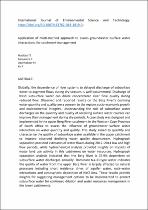 ResearchSpace
ResearchSpace
Application of multi-method approach to assess groundwater–surface water interactions, for catchment management
JavaScript is disabled for your browser. Some features of this site may not work without it.
- ResearchSpace
- →
- Research Publications/Outputs
- →
- Journal Articles
- →
- View Item
| dc.contributor.author |
Madlala, Tebogo E

|
|
| dc.contributor.author |
Kanyerere, T

|
|
| dc.contributor.author |
Oberholster, Paul J

|
|
| dc.contributor.author |
Xu, Y

|
|
| dc.date.accessioned | 2018-09-18T07:46:17Z | |
| dc.date.available | 2018-09-18T07:46:17Z | |
| dc.date.issued | 2018-06 | |
| dc.identifier.citation | Madlala, T.E. et al. 2018. Application of multi-method approach to assess groundwater–surface water interactions, for catchment management. International Journal of Environmental Science and Technology: https://doi.org/10.1007/s13762-018-1819-3 | en_US |
| dc.identifier.issn | 1735-1472 | |
| dc.identifier.issn | 1735-2630 | |
| dc.identifier.uri | https://link.springer.com/article/10.1007/s13762-018-1819-3 | |
| dc.identifier.uri | https://doi.org/10.1007/s13762-018-1819-3 | |
| dc.identifier.uri | http://hdl.handle.net/10204/10404 | |
| dc.description | Copyright: 2018 Springer. Due to copyright restrictions, the attached PDF file only contains the abstract of the full text item. For access to the full text item, please consult the publisher's website. | en_US |
| dc.description.abstract | Globally, the dependence of river systems to delayed discharge of subsurface water to augment flows during dry seasons is well documented. Discharge of fresh subsurface water can dilute concentrated river flow quality during reduced flow. Observed and reported results on the Berg River’s declining water quantity and quality are a concern to the regions socio-economic growth and environmental integrity. Understanding the role of subsurface water discharges on the quantity and quality of receiving surface water courses can improve their management during dry periods. A case study was designed and implemented in the upper Berg River catchment in the Western Cape Province of South Africa to assess the influence of groundwater–surface water interaction on water quantity and quality. This study aimed to quantify and characterize the quality of subsurface water available in the upper catchment to improve observed declining water quality downstream. Hydrograph separation provided estimates of water fluxes during 2012–2014 low and high flow periods, while hydrochemical analysis provided insights on impacts of major land use activity in this catchment on water resources. Hydrograph separation analysis indicated that the Berg River is 37.9% dependent on subsurface water discharges annually. Dominant Na–Cl-type water indicates the quality of water from the upper Berg River is largely affected by natural processes including short residence times of aquifer water, rock–water interactions and atmospheric deposition of NaCl ions. These results provide insights for suggesting management options to be implemented to protect subsurface water for continued dilution and water resources management in the lower catchments. | en_US |
| dc.language.iso | en | en_US |
| dc.publisher | Springer | en_US |
| dc.relation.ispartofseries | Worklist;21281 | |
| dc.subject | Base flow | en_US |
| dc.subject | Integrated water resources management | en_US |
| dc.subject | River self-purification | en_US |
| dc.title | Application of multi-method approach to assess groundwater–surface water interactions, for catchment management | en_US |
| dc.type | Article | en_US |
| dc.identifier.apacitation | Madlala, T. E., Kanyerere, T., Oberholster, P. J., & Xu, Y. (2018). Application of multi-method approach to assess groundwater–surface water interactions, for catchment management. http://hdl.handle.net/10204/10404 | en_ZA |
| dc.identifier.chicagocitation | Madlala, Tebogo E, T Kanyerere, Paul J Oberholster, and Y Xu "Application of multi-method approach to assess groundwater–surface water interactions, for catchment management." (2018) http://hdl.handle.net/10204/10404 | en_ZA |
| dc.identifier.vancouvercitation | Madlala TE, Kanyerere T, Oberholster PJ, Xu Y. Application of multi-method approach to assess groundwater–surface water interactions, for catchment management. 2018; http://hdl.handle.net/10204/10404. | en_ZA |
| dc.identifier.ris | TY - Article AU - Madlala, Tebogo E AU - Kanyerere, T AU - Oberholster, Paul J AU - Xu, Y AB - Globally, the dependence of river systems to delayed discharge of subsurface water to augment flows during dry seasons is well documented. Discharge of fresh subsurface water can dilute concentrated river flow quality during reduced flow. Observed and reported results on the Berg River’s declining water quantity and quality are a concern to the regions socio-economic growth and environmental integrity. Understanding the role of subsurface water discharges on the quantity and quality of receiving surface water courses can improve their management during dry periods. A case study was designed and implemented in the upper Berg River catchment in the Western Cape Province of South Africa to assess the influence of groundwater–surface water interaction on water quantity and quality. This study aimed to quantify and characterize the quality of subsurface water available in the upper catchment to improve observed declining water quality downstream. Hydrograph separation provided estimates of water fluxes during 2012–2014 low and high flow periods, while hydrochemical analysis provided insights on impacts of major land use activity in this catchment on water resources. Hydrograph separation analysis indicated that the Berg River is 37.9% dependent on subsurface water discharges annually. Dominant Na–Cl-type water indicates the quality of water from the upper Berg River is largely affected by natural processes including short residence times of aquifer water, rock–water interactions and atmospheric deposition of NaCl ions. These results provide insights for suggesting management options to be implemented to protect subsurface water for continued dilution and water resources management in the lower catchments. DA - 2018-06 DB - ResearchSpace DP - CSIR KW - Base flow KW - Integrated water resources management KW - River self-purification LK - https://researchspace.csir.co.za PY - 2018 SM - 1735-1472 SM - 1735-2630 T1 - Application of multi-method approach to assess groundwater–surface water interactions, for catchment management TI - Application of multi-method approach to assess groundwater–surface water interactions, for catchment management UR - http://hdl.handle.net/10204/10404 ER - | en_ZA |





